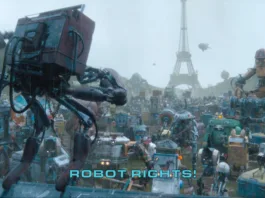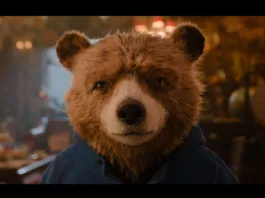VFX Supervisor James MacLachlan began his career in New Zealand in 2001 and has since worked with various studios across New Zealand, Australia, and the UK. Based in London for the past 19 years, he has brought his expertise to acclaimed projects such as Ted Lasso (Seasons 2 and 3) and most recently, the seventh season of Black Mirror.
What is your background?
I’m a native kiwi living and working in the UK now for the last 19 years. I’ve had the privilege of working within VFX teams both client-side and in-house, pushing pixels with wonderfully talented people in the UK, New Zealand, and Australia.
My career began in high-end advertising vendor studios, laying the foundation for a deep understanding of the entire VFX process. Five years ago, I transitioned to production-side work. From script breakdown to final delivery.
Over the years, I have supervised high-end VFX for TV series, feature films, commercials, music videos, interactive campaigns, and more. Most recently I was the VFX Supervisor on Ted Lasso – Seasons 2 and 3.
How did you get involved on this show?
My agent Harriet Donnington was approached about the show and put my name forward to Dan Barrow (Snr VFX Manager) at Netflix. Dan introduced me to VFX Producer Josie Henwood who already had a season of Black Mirror under her belt, and the rest fell into place very neatly. There was a synergy about the project that felt very right.
What was your feeling to be part of this iconic series?
My initial feelings were – I was extremely honored and humbled. To be fair, I still am. Black Mirror has been a seminal part of the television landscape and it’s a psyche I really lean into. The thoughts and themes have always resonated with me. I’ve got a bit of a dark side (and humour) so I really hoped I could do my best and play a small part in bringing the show to the audience. It’s a very exciting show to be a part of.
How was the collaboration with creator Charlie Brooker?
Phenomenal. I’ve followed and watched most of Charlie’s works over the years. Sometimes unintentionally… Shout out to mid-80s prepubescent magazine Oink!. It’s really really great fun watching Charlie riff on ideas (especially in a room full of creative writers/directors & playmates). He’s a font of knowledge on all things Black Mirror and often finds references and examples of what he’d love to convey in shots and sequences in the strangest of places. The references (no matter how obscure) are always bang on, which makes our job in VFX that much easier.
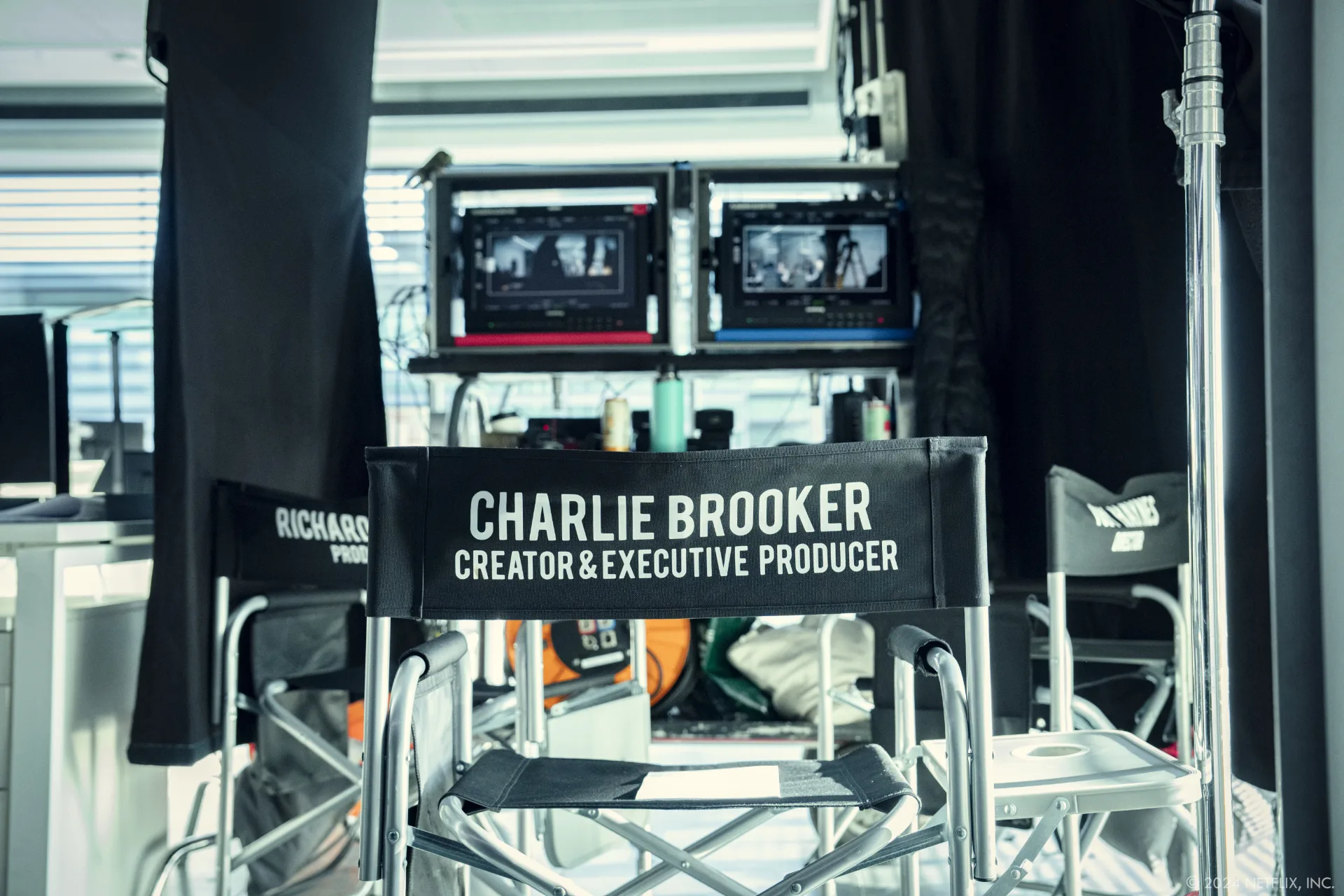
How did you choose the various vendors and split the work amongst them?
Josie had come off Season Six of Black Mirror not long before and the vendors had all done a really great job. I met with the producers and creatives at each studio, looking through their previous shows and efforts. Every time I met with a new studio I would bump into ex-workmates, which further supported my trust in their abilities. We obviously had a keen eye on a few new studios to bring into the fold, which also worked in our favour. The creative was allocated to lean into each studio’s strengths, with the belief they would all want to be pushing the boundaries a little further at every opportunity. Crafty Apes, Jam VFX, Jellyfish Pictures, Magic Lab, One Of Us, Stargate Studios, Terraform Studios and Union VFX delivered stellar creative solutions to the highest standard for the VFX this season. They were amazing.
Black Mirror is known for its ability to explore a wide range of genres and visual styles. How did you approach this variety as a VFX supervisor? Did each episode present unique challenges?
This is what I really loved about being able to help on Black Mirror. There was a very very wide spectrum of VFX requirements this season (as there has been in previous seasons). Across the episodes we had epic space battles, immersive Polaroid encroachment, vintage British film, 90s Video gaming artificial lifeforms, frothing acolytes & sadistic websites. While there is consistency with Charlie helming Black Mirror, every episode brings a new flavour to the aesthetic and approach with new Writers, Directors, DOPs & Production designers. This variety is what made Black Mirror so exciting for me. In VFX we really embraced the variation and the new challenges presented daily. In a funny way, I think many of us on the VFX crew were able to separate our solutions in a more concise way because the individual episodes were so distinguishable.
How do you adapt the visual effects to suit the specific atmosphere of each episode? Are there recurring elements in the way you approach VFX for Black Mirror, or is it a completely different process every time?
The atmosphere for the show is a magical combination of the words on the page, the director’s vision and that innate chemistry the actors bring to the frame. Personally I feel spending as much time in pre-production as possible listening to these voices is key. It’s a great foundation moving forward.
With Black Mirror there is a canon of work that has been created over the years which we can lean into, while every show brings a new approach to how the VFX solutions are applied. There’s a few VFX elements and designs that viewers will spot are similar across seasons and episodes (nubbin animations, screen treatments, and eye milking etc) but they all come with very subtle differences. Each show has its own personality and process. It’s fresh everytime.
What made this season really fantastic was the consistency with the production-side VFX team. Our shorthand communication and ability to handle multiple shows at one time really paid off.
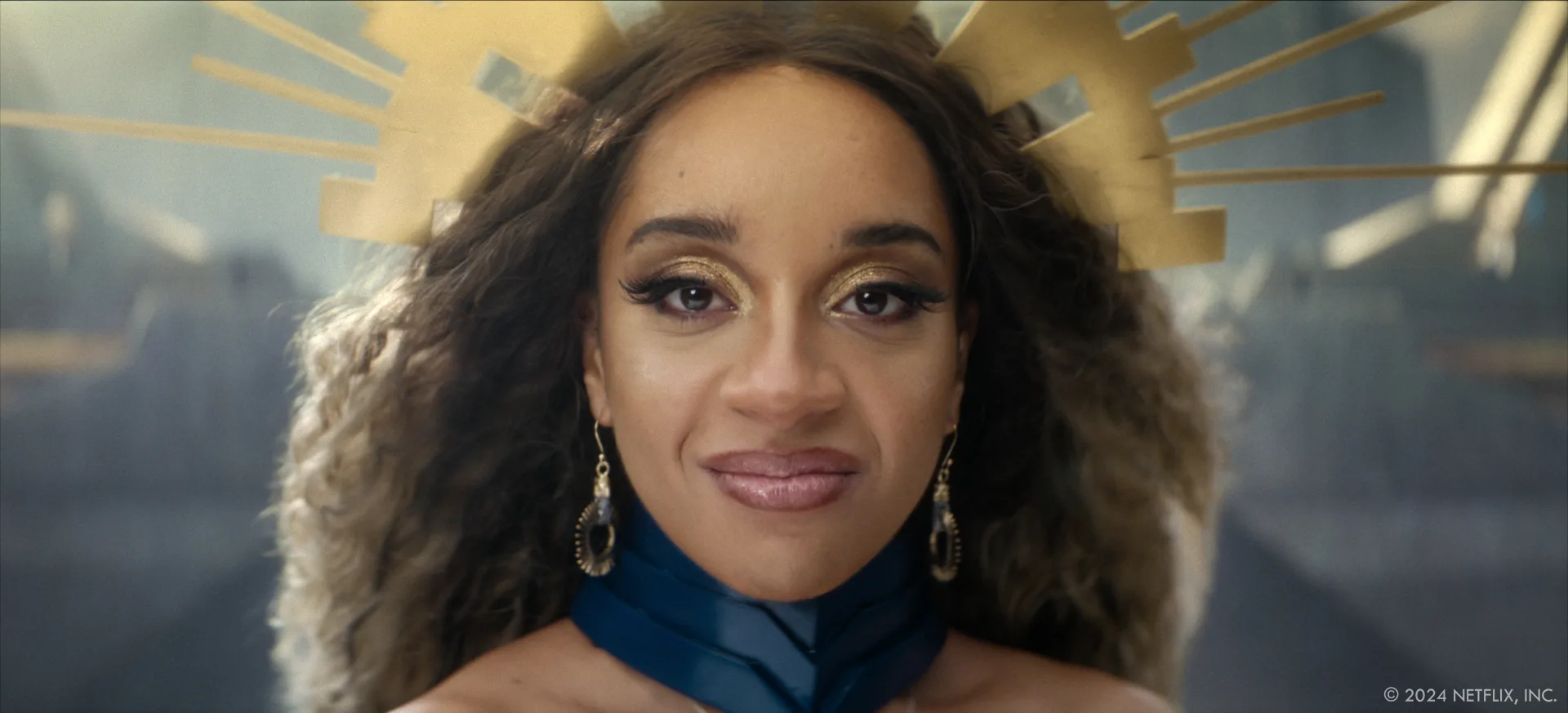
Season 7 features striking contrasts between episodes. What was the biggest challenge in maintaining visual consistency while respecting the unique identity of each story?
It’s great you picked up on the contrasts, each episode really was quite different from one another aesthetically. That’s the beauty of the Black Mirror anthology. Charlie has a very defined approach to the themes, and an overview of the series that manages to maintain its ethos.
The unique identity of each show was driven by the writing and direction, so it was a case of listening to the directors on each show and following their lead. It was amazing to hear the individual approaches to each show and running through deep research and development phases, with a solid VFX design process to set the look and feel of each show. USS Callister – Into Infinity was a great example here.
The VFX in the episode stood out as modern, clean, and driven by technology. Elements like the Spaceship designs, Heart of Infinity, teleportation, fragging and the UI/UX designs each required individual attention, yet needed to feel cohesive within the story. A consistent thread of modern gaming language helped unify them, guided by the sharp eyes of Toby and Charlie.
Many of the people responsible for deadlines on the project would argue the biggest challenge was staying on a single path through this process, as there were so many exciting options available. It was awesome. We took a full road trip across the creative spectrum with loads of extremely talented artists along the way. It was a wonderfully collaborative process where many questions would pop up. In VFX we were always striving to answer the questions with solid solutions that spoke to the creativity.
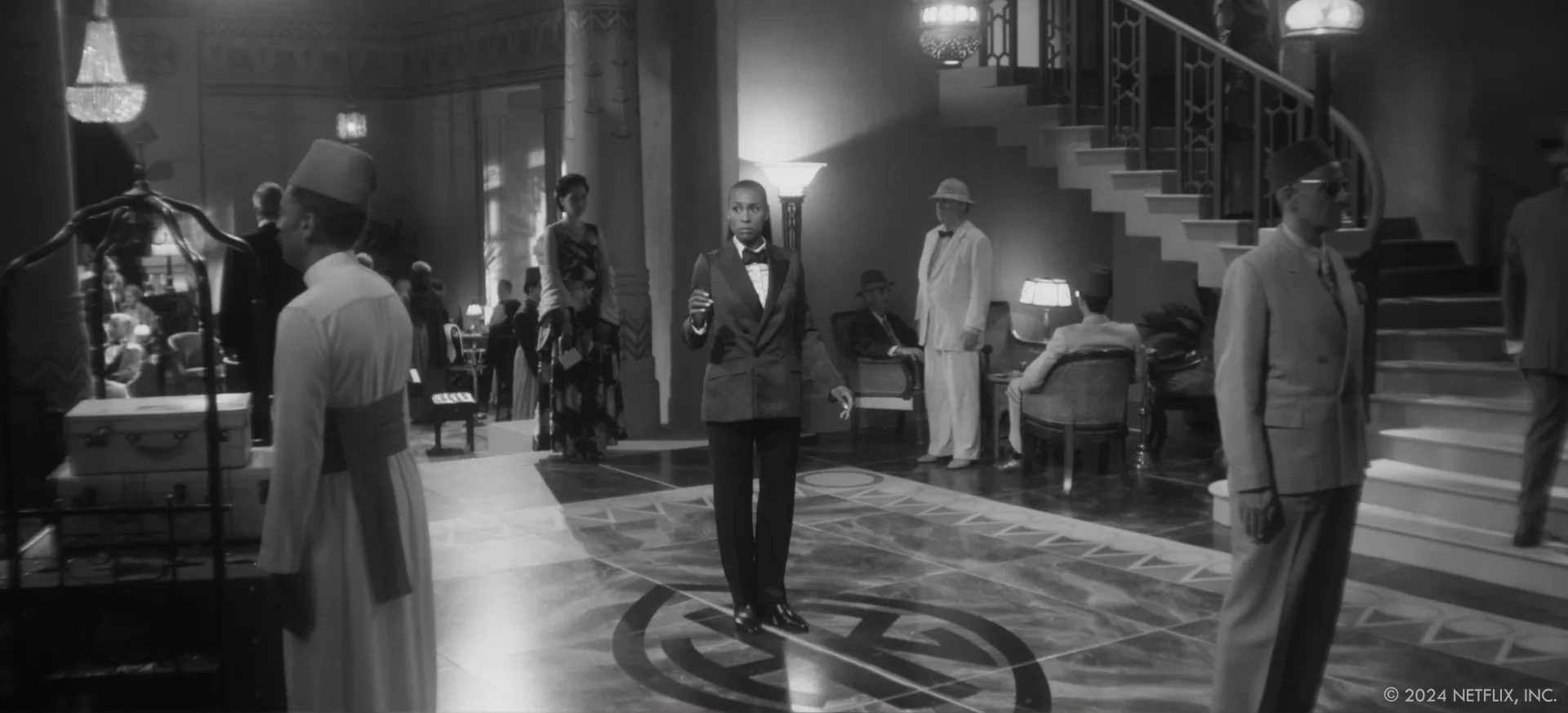
The episode Eulogy features fascinating visual effects where characters “enter” photographs and discover what’s hidden behind them. What was the creative and technical process like for making this interaction with the photos both realistic and surreal at the same time?
Directors Us (Chris Barrett and Luke Taylor) came to the project with very distinct ideas for what they wanted to achieve with these moments. They discussed the Trompe-l’œil effect and how we can achieve the ‘breaking of the frame’ when we first move our master camera from its starting position.
We enlisted Victor Tomi and the uber talents at VFX studio One of Us who set about creating some Pre-vis tests to show how the scenes would look if there was no light on the surfaces not visible to the ‘master prop camera’. These went down very well with everyone, now we just needed to figure out the best approach for shooting.
It was very important that Paul and Patsy had tangible environments with which to interact. Chris and Luke established early on that for the photographic worlds to feel authentic, there needed to be frozen actors in the spaces, with perceived motion from before photos were taken. Movement Choreographer Polly Bennett spent a lot of time in pre-production setting about solving this. It was amazing to watch Polly, Chris and Luke in action while making notes and offering suggestions for how we could help out in VFX.
During this early process, we enlisted the help of Ironworker Mark Strange to create a kit of parts that could support actors in hundreds of positions. These malleable stands and supports were hidden in hundreds of places throughout the shoot, under feet, behind lower backs, even under costumes all the way up to the wrist. In VFX, we knew this would save time and money down the line, meaning we could focus our attention elsewhere.
With DOP Alvaro Gutierrez we did lighting tests on a camera test day to determine a few ‘best practices’ for avoiding camera shadows, and utilizing a small (but extremely powerful) battery powered LED source, we could shoot ‘lighting flash passes’ on set for reference. This in camera light was essential to the feeling of being present.
We also knew, for accuracy, we would need full lidar scans of most of the sets, with actors holding still. We enlisted Lidar Lounge who were absolutely fantastic with scanning the larger sets, keeping the actors well informed as to how long they’d need to hold still (always just a bit longer…). We now had our shooting approach.
The shoot was an amazing experience.
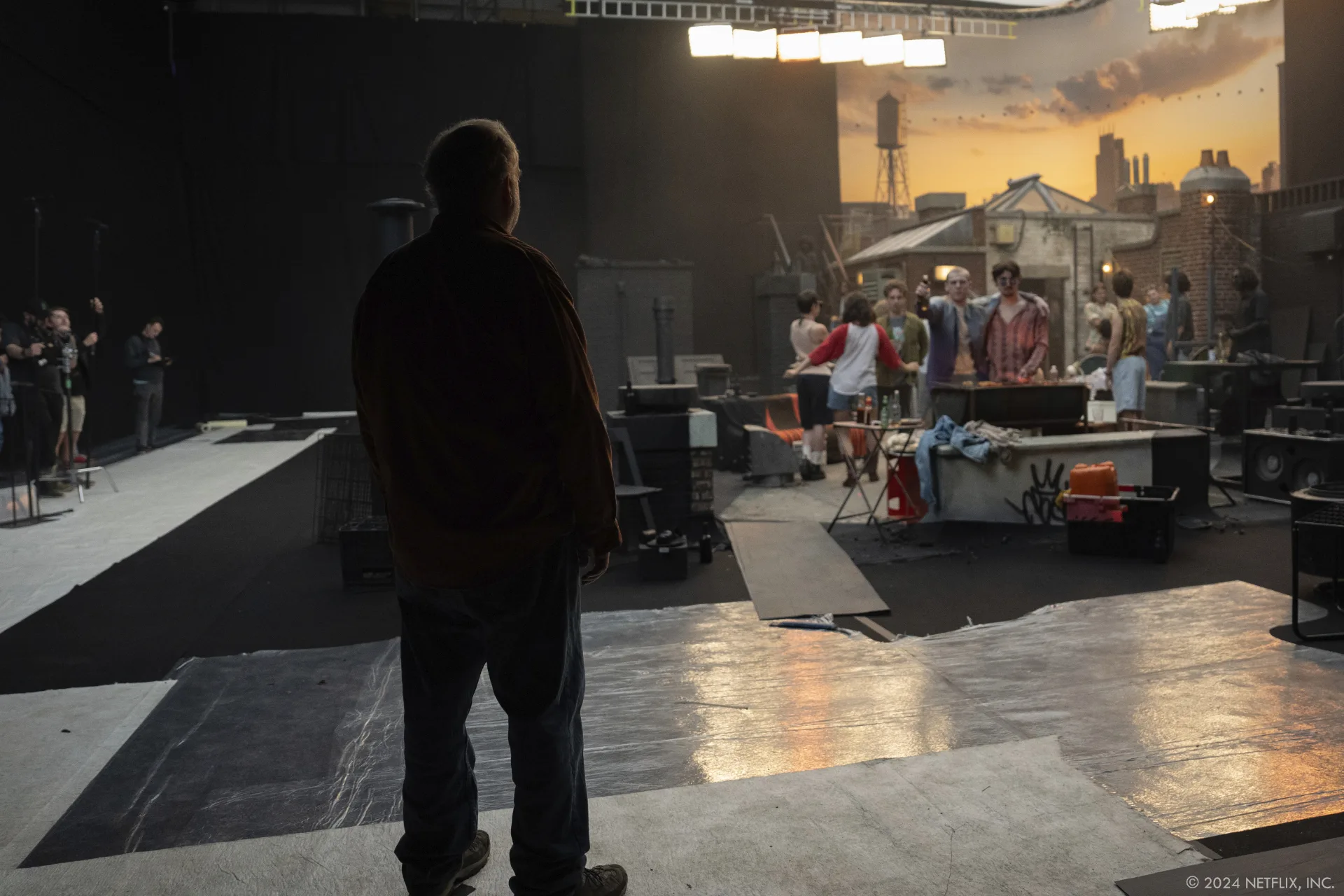
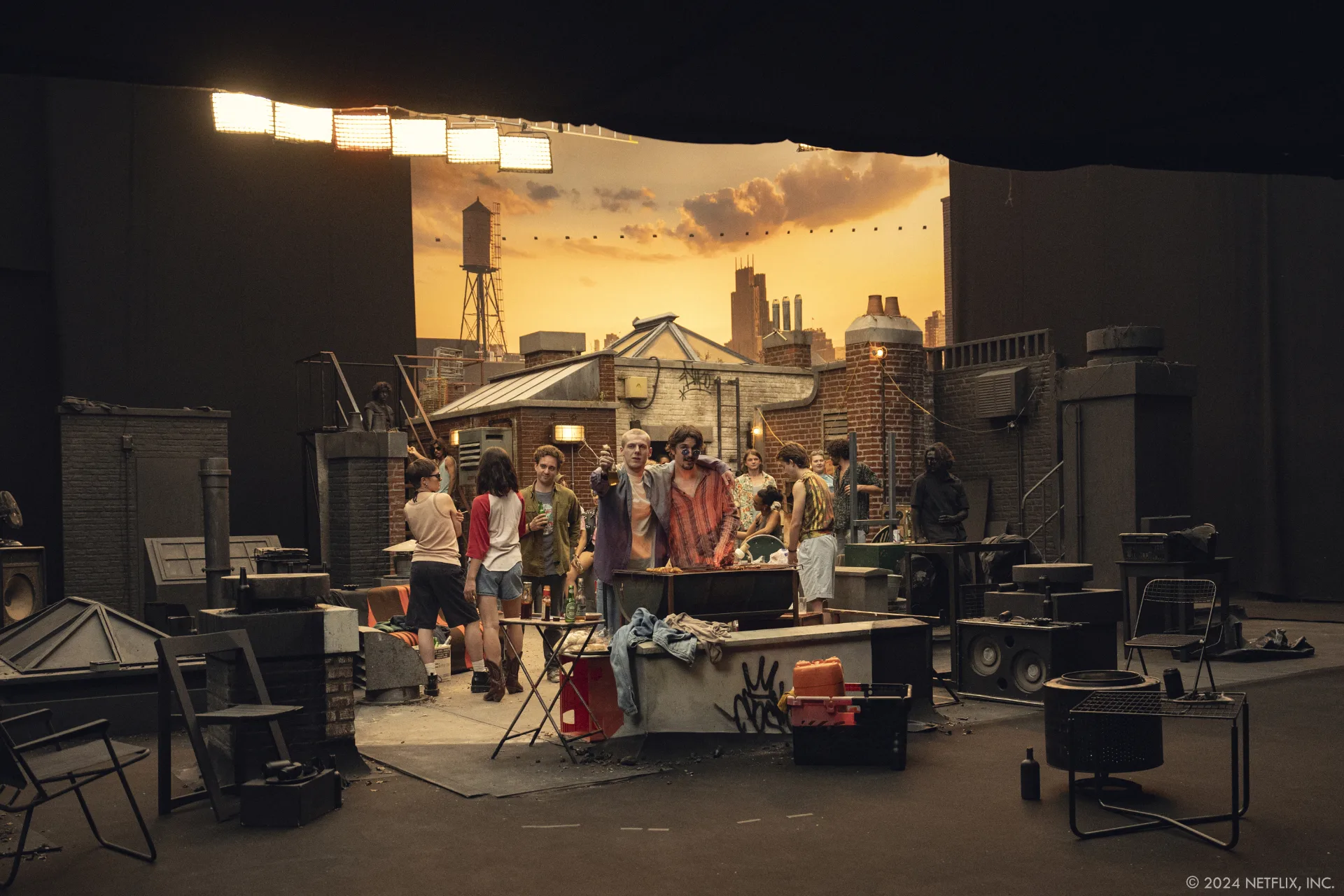
Once back with One of Us in the VFX studio, we had flexibility to try out a number of creative choices given the way we had shot. With light completely occluded on the surfaces not revealed by the ‘prop camera’ in each scene, it was deemed a little dense and felt like a cookie cutter had been taken to the scene. The hero camera (Alexa) Depth-of-field played a large part in our discussions. Victor and the team went through a palette of options and ideas regarding the ‘dark side’, with us finally landing on a solution Us and Charlie really loved.
It is important that the scenes the audience see on the episode are showcasing the capabilities of Eulogy. It’s a digital representation of a perceived reality. Because of this, the low faceted surfaces were embraced in the first photo, and as the episode developed so too did the capabilities of Eulogy to determine spaces. The pictures became clearer.
To make the transition between the real world and the photo universe believable, did you use specific techniques, such as augmented reality or image manipulation processes? What were the main compositing challenges in creating this effect?
As the sets were being constructed, I followed Chris, Luke and Alvaro closely to determine where the ‘hero prop camera/flash’ placement would be. We shot multiple Polaroid tests in a number of sets to help determine the framing. I also took the opportunity to shoot colour charts & chrome balls should I need to sample them and compare to the Alexa footage at a later date.
Once we had the hero positions of the prop cameras, we then carefully marked out where the nodal center of that lens would be, and determined the best lens size for each photographic setup. I then set about helping Production Designer Robin Brown determine where needed to be ‘blacked out’. We went old skool. I got out my laser measures and marked up the sets with tape. Robin and his team then set about painting everything matte black. Beautiful sets to see in the flesh.
The main challenge for the compositing team when leading into these initial scenes was the differentiation of the edges between the ‘dark side’ and the photographically revealed surfaces. These edge transitions had to work in a 3D space, while being slightly softened and photographic in approach. Another challenge we faced was the way the light played across the surfaces on the ‘dark side’ and making them feel like a satin paint or fabric, rather than too glossy. The compositing team at One of Us did exceptional work on the integration. No mean feat.
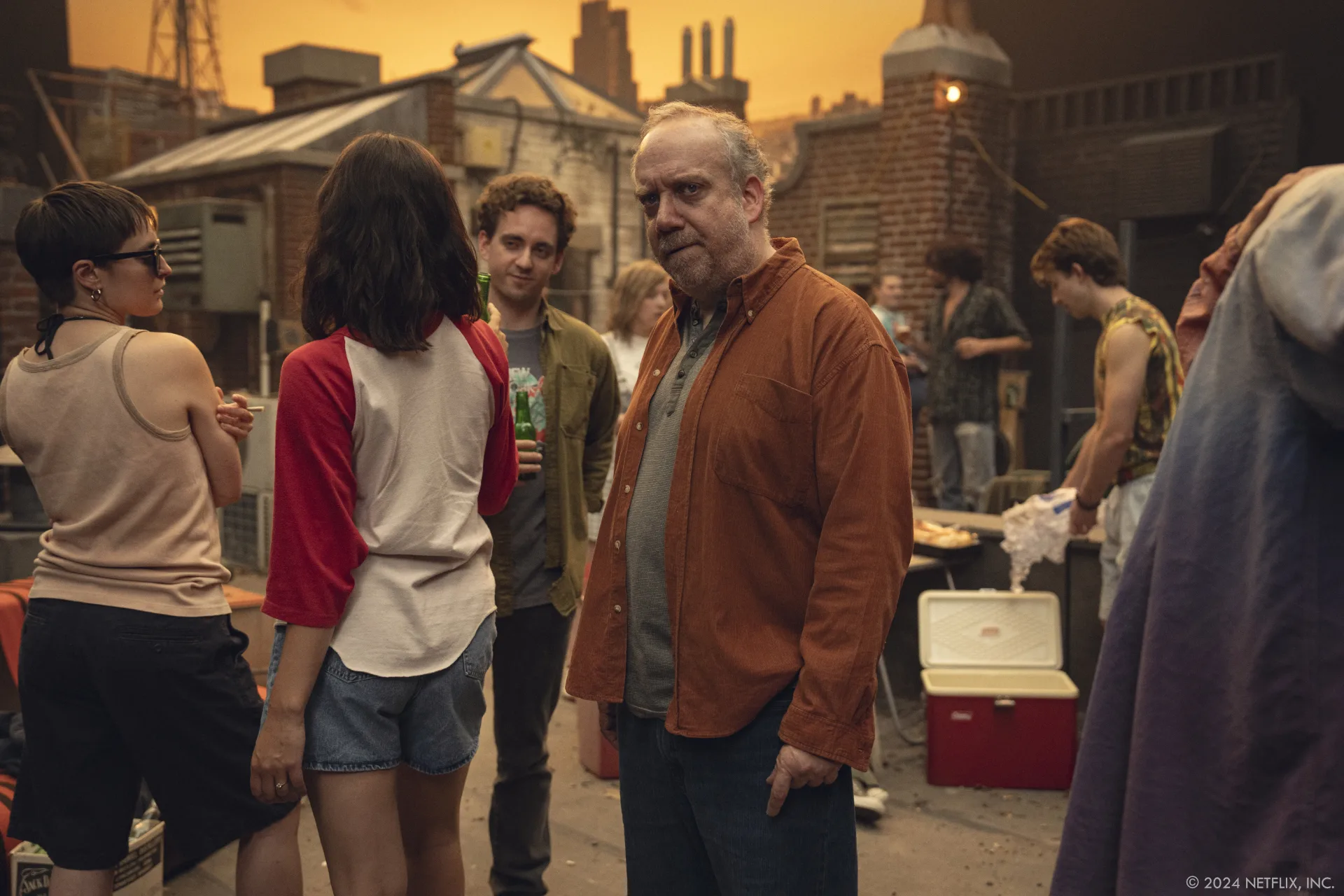
How did you handle the characters’ interactions with the photo elements, especially in terms of reflections, shadows, and textures, to make it feel organic rather than just a visual effect?
A lot of time was spent analysing film negative techniques, technologies and aesthetics. I’m a long time lover of all things photographic. There is an inherent tangible texture to film photography. There was a concerted effort to have the shots feel chemically photographic rather than digital. The motion blur, light leaks, motion streaks and dust moats proved to be more involved than initially thought, and really paid off. These elements had to live within a 3D space as the camera moved freely around the scene. We even tried planes of grain within the space, but this got a little too messy when the hero camera would pass too closely to the plane.
The USS Callister episode features an iconic spaceship and spectacular space battles. Can you walk us through the process of creating the ship, particularly the design choices that helped make it stand out in the Black Mirror universe?
The process for creating USS Callister was a really exciting journey. Obviously this episode is a sequel (also directed by Toby Haynes) so we had a back catalogue of content that had been created in the previous episode which was a fantastic springboard with which to move forward from. We were really fortunate Framestore were able to wrap-up and share the 2017 model from the original show.
This proved to be a really great starting point for Union VFX to begin re-texturing and re- shading the model for the systems that are now used in their pipeline in 2025. A fair amount of attention was given to the very subtle details of the surface textures and I particularly enjoyed the development of the thrusters and the way that they emitted Photon light behind the ship as it travelled, accelerated and banked.
The USS Callister was by no means the largest CGI build for this episode. That honour goes to the Heart of Infinity. We began designing the Heart of Infinity with a solid concepting process in conjunction with Toby, Charlie and Production Designer Miranda Jones and her team. We took a brief from Toby that involved large concentric rings rotating around one another in an ominous fashion. Very intimidating.
Initially the brief involved a huge ring shaped spaceship that had metallic thorns and shards protruding from it that made it look like you wouldn’t want to visit the surface. The deeper we got into the design process the more our options opened up. It was very rewarding. Collectively we then leaned into some more interesting and intricate designs that involved armillary spheres (which was a nice celestial touch), rotating gyroscopic concrete and metal structures and long thin glass shards. Tip of the hat to The Labyrinth and Event Horizon.
We discovered fairly early into this process that any lights we placed on the Heart Of Infinity made it feel like people were living within (especially small lights – like windows), so, given we wanted to keep people off this object and make it feel intimidating we nixed these. At one point we even had an Earth like feature at the center, however Toby and Charlie felt this was too inviting, so it went the way of the dodo.
At this point David Schneider and the team at Union entered the frame and started to model and animate the HOI. Gradually over time we resolved to a solution that involved concentric Rings passing around one another chopping like guillotines.
Charlie and Tobys addition of millions of PCB boards across the surfaces was a great textural detail and a clever nod to the game’s setting within a computer cloud system—bringing everything together neatly. We were good to go.
Regarding the planets and space environments, how did you approach their creation visually? Were there any specific references you used to imagine these worlds, or did you lean towards a more experimental approach?
We really didn’t mess around on this one. We were researching online for deep space planetary worlds and designs, and VFX Production Manager Kübra Tanyel discovered artist Mark Kolobaev who was represented by Terraform Studios. Mark had a fantastic back catalog of concepts and designs that he had created over the years and we felt he was the right artist at the right time for the right project so we set about making sure that he was part of our team. Mark came up with some fantastic ideas that were then translated across to Union, who set about creating all of the concepts in motion. It was a really fluid process.
Very early on – in conjunction with DOP Stephan Pehrsson, we decided we would test running an LED wall in the Callister Bridge. We discovered there was a twofold solution for us all. Stephan would be able to use the physical light the LED wall cast around the stage – lots of beautiful reflections from all the shiney chromed metal surfaces and the faces of the actors. While at the same time, it would reduce the VFX shot count with VFX mostly avoiding green screens and spill. Josie Henwood cleverly ran the numbers in depth, and we discovered that it was the best approach.
The USS Callister bridge was an exciting set to be on. What I hadn’t considered was the reaction of Cast and Crew. It was a wonderful experience seeing the actors (who had been on a similar bridge in 2017) reacting to the space designs and hyperspace when it was played. All in all we created most of the space designs, planet orbiting designs, hyperspace, laser fire before we played all of these live through the LED wall as we shot. We also had green and grey screens available at the touch of a button. Django and the team at VSS did an exceptional job of preparing, rotating, moving, shifting, sliding, scaling these designs to Stephan and Toby’s needs for any given shot. It was very immersive.
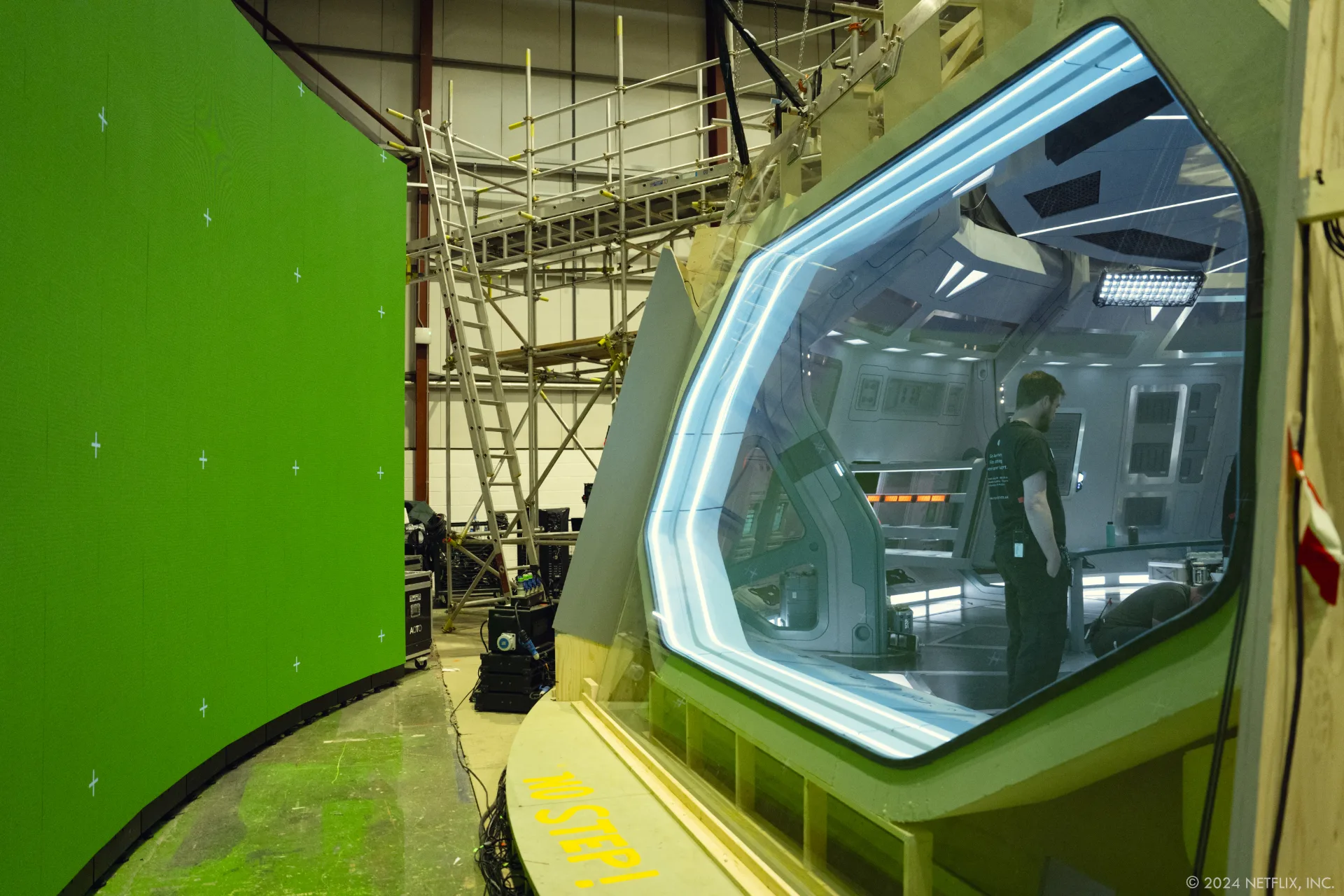
The final space battle in USS Callister is impressive, with numerous ships in action. What challenges did you face when coordinating these scenes, especially in terms of simulating movement and the interactions between the ships?
There’s a lot going on in the final space battle scenes. We knew this battle would take place in a dark area of the Universe, we wanted a strong hard light from one side creating an ominous atmosphere. So, with little fill light to play with, we had to determine how to ensure that the individual fighter jets stood out on this inky background. David and the team at Union took the designs of the fighter jets, modelled them and accentuated their designs with coloured emissive lights. This really helped with the understanding of which individual ships were battling at what moments with the Callister.
We were invited really early on to see the cockpit builds for the set. They looked fantastic, very tangible and authentic. With this in mind we knew we needed to convey convincing speed and rotational movement. Together with Stephan and his team we devised a rig with a swinging light on a huge arm that arced over the stationary cockpit. There was also an additional set of Arri panels surrounding the cockpit for colour tints and bright flashes. With Toby standing on the nose of the fighter Jet relaying instructions, the lighting team did an amazing job of keeping the practical lighting moving. Then, in VFX we made sure the external lighting of the CGI environments matched the interiors. Animators followed the in-camera light sources. Lead Data Wrangler Nicky Ruffell ensured we had all the colour charts, chrome balls, reference images and witness cameras we needed to match back to the in camera lighting.
The CGI movement and interactions between the ships was a constantly evolving collaborative process. We began with what can only be described as poor tai chi movements with our hands swooping around as we filmed ourselves, followed up by paper planes and iPhone recordings, to then enlisting Jamie and the team at Big Tooth who did an utterly fantastic job with creating shots from our wild gestural explanations and notes. These previs shots then fed through production, with both editing and the VFX finding them extremely useful for timing, pacing, and general storytelling. Every step of the way Toby and Charlie brought great ideas to us and often supported by really interesting references.
Union then took the previs designed shots and integrated them into full production for the entire show. Viewers have a very defined expectation of how fighter jets fly and react within a space environment. We’ve all spent many years looking at all the fantastic films and TV series from Star Trek to 2001: A Space Odyssey, Star Wars to Interstellar, even Top Gun and WW2 fighter jet footage. There’s a wealth of resources to pool from when deciding how these ships should move. It’s an interesting balance between feeling the weight of the ship as they plow into surfaces and understanding what happens to a ship when it’s out of control and space. Layered within that is the fact this is happening within a game. Big tooth and Union really leaned into these references and we all felt like we were standing on the shoulders of giants.
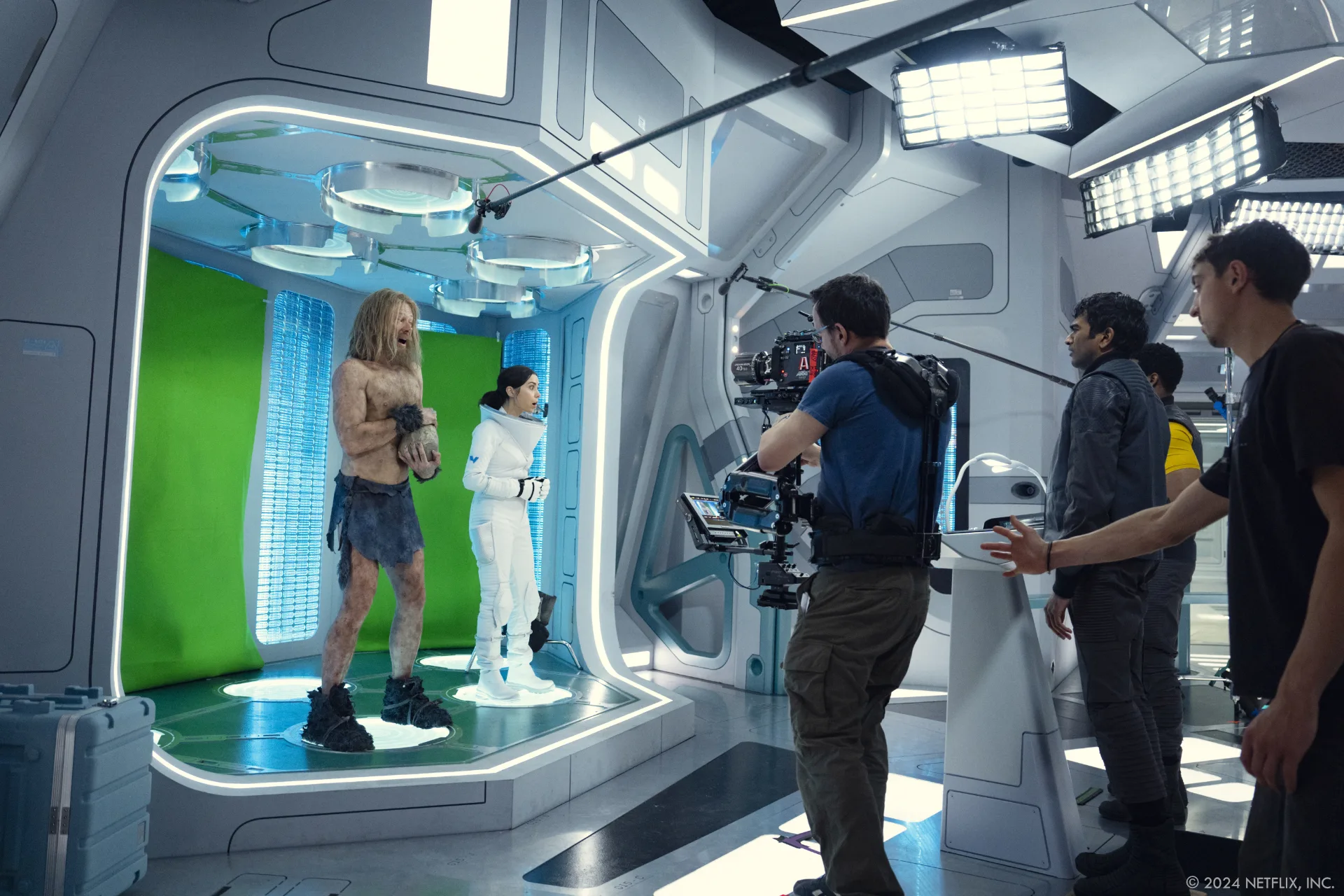
Looking back on the project, what aspects of the visual effects are you most proud of?
I’m definitely proudest of the people I met along the way and the scope of work we were all able to achieve together. With Black Mirror I was lucky enough to surround myself with some of the best in the business and learn as much as I could along the way.
It’s amazing to think that together with Charlie, the writers, the directors, the producers, our production-side VFX team and everyone on-set from production designers, to costume, special effects to art department, stunts to HMU and the huge teams of artists and support staff at the VFX Studios, we helped bring so many shots to life.
Across the season, through millions of conversations, the VFX team were entrusted with assembling the final shots for space battles, Hearts of Infinity, entering photographic worlds, exiting filmic worlds, fighter jets, hyperspace, teleporting, gaslighting audiences, fragging, stunt wire work, ice planets, cloning characters, UI and UX designs, rooftop environments, tripping on the tube, screaming swathes of acolytes, killing some Thronglets, sound-driven nubbins and milky irises.
I’m proudest of the teams of people who produced such a wide scope of work.
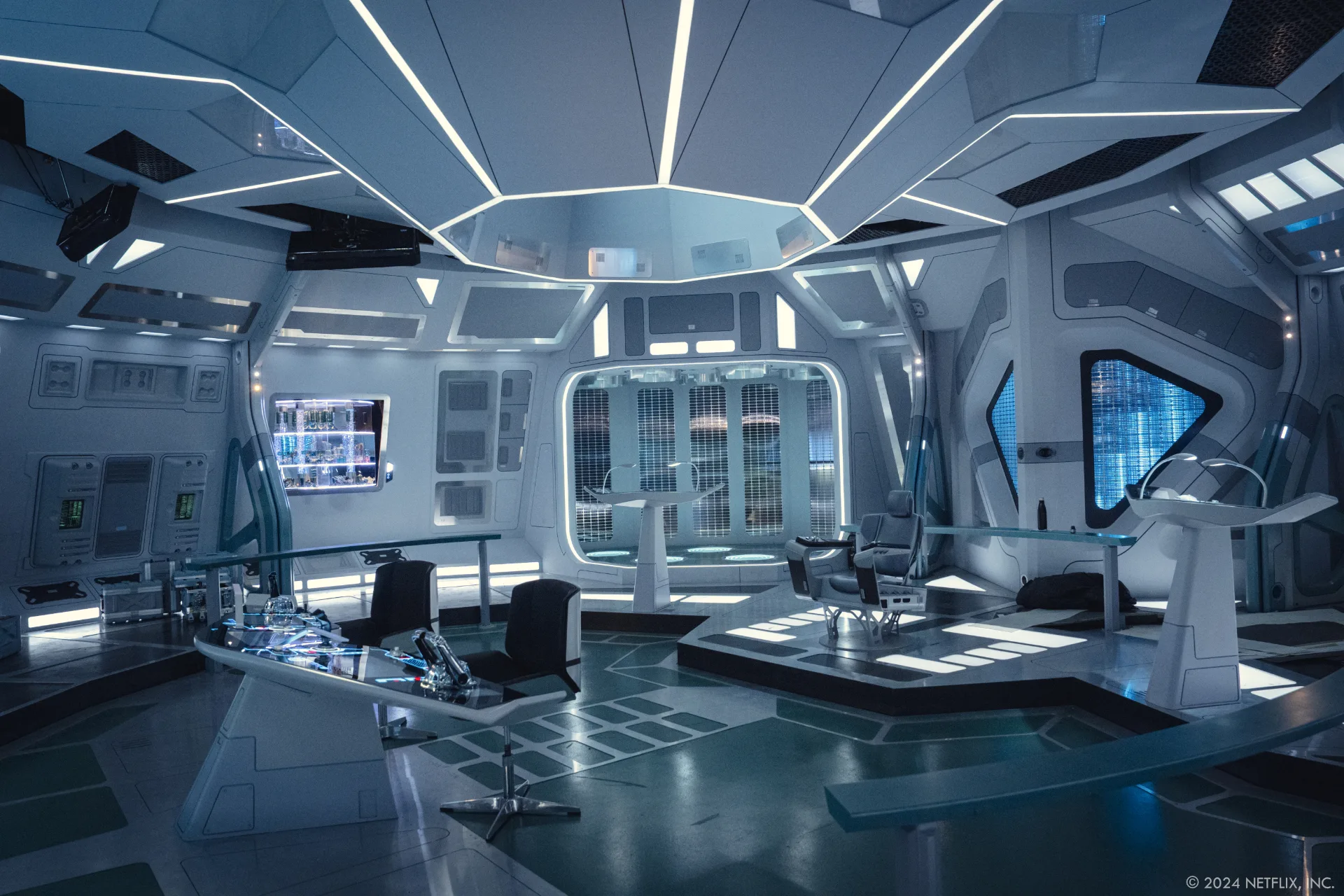
How long have you worked on this show?
In the mid-1980s in New Zealand my dad brought home a VHS recorder and the first thing I recorded off the TV was Star Wars: A New Hope. The argument would be that I began working on this project around that time as I wore out the VHS tape watchin it thousands of times….but my contract with Black Mirror would say about 14 months.
What’s the VFX shots count?
In USS Callister – Into Infinity there were 669 shots finalled by the VFX artists, and across the Black Mirror series there were more than 1600 shots that required help from the VFX Department. I can’t thank the teams enough.
What is your next project?
I can’t talk about what that might be right now. But I’m really excited for what this year holds.
A big thanks for your time.
WANT TO KNOW MORE?
One of Us: Dedicated page about Black Mirror – Season 7 on One of Us website.
© Vincent Frei – The Art of VFX – 2025


